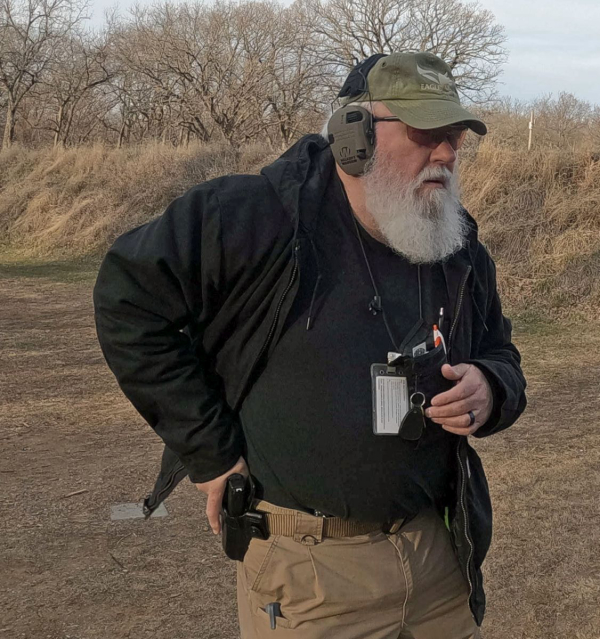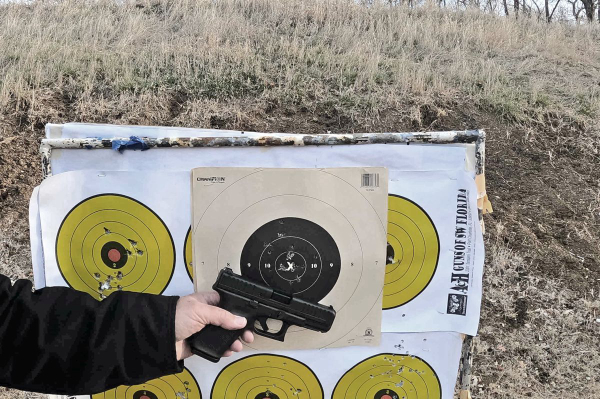The annual qualification for retirees under provisions of the federal “Law Enforcement Officers’ Safety Act” and relevant state enabling legislation and rules was looming. While our state qual course is nothing to fear, I thought it still wouldn’t hurt to knock some of the rust off.
That said, being a pensioner meant I tend to watch pennies and so I elected to use a rimfire analog to the pistol I normally carry.
About this time, I’ll be catching flak from those who will note that “only a Fudd practices with a 22” and “the centerfire gun recoils more than the plinker.”
Right, likely as not, in both cases.
I find the time limits on the state course to be … generous. Likewise, I find that the 22-auto pistol is more likely to experience a failure to fire or other stoppage than my service-compact carry pistol. That means I can spend some time on stoppage reduction – for the unlikely situation I’d face one at the department range.


Besides, the problem with qualification is more score-on-target than how-much-time is used. I’d prefer to take care of the accuracy part of the equation.
To use the same size holster and magazine pouch, I’d use an analog to my carry GLOCK 19, the GLOCK 44. It doesn’t have the nice sights nor the Talon Grip than the Gen5 does, but it fits the carry gear and feels “close enough” to get some training effect.
For the holster, I used an original Galco S.S.S., Side Snap Scabbard. It fits close to the body as the back of the holster is a flat sheet designed to fit around the wearer’s body. The outside of the holster is precision molded to the gun it’s made to fit. There is a tension adjustment screw under/behind the trigger guard.
This holster isn’t the current, improved Side Snap Scabbard. Like the original, it has the quick on-off snap loops that fit 1 1/2” belts. It’s an open top design with a reinforced mouth for smooth and easy one-handed re-holstering. The newer version has a slight butt-forward cant, unlike the steeper angle of the earlier version.
I was working on a carton of Federal AutoMatch. A bulk-packed load, it’s meant to function 22 autos. Like any 22, the G44 is prone to minor interruptions in the cycle of operation.


To quiet the din of the mob, I stapled up a B-8 repair center. It’s vastly smaller than the FBI-Q ‘bottle’ target. The bull gives me an aiming point; I just can’t sight in on that tiny “Q” on the qual target at any distance.
I did a 30-round practice. Starting from the holster and from ‘guard,’ shooting mostly 1-handed (it’s not supposed to be easy) with either hand, I worked a few rounds from as close as three-yards back to fifteen yards. The resulting target showed four hits high in the “9” ring, six in the ’10’ ring and the remaining ten hits went into the tie-breaking “X” ring.
What did I find out?
Well, it took some time to get those hits. I’ll be shooting a bit faster at the agency’s event. I’ll also be shooting less one-handed than I did for practice and the target is larger.

I experienced a neat stoppage. It began with a failure to fire. I believe the slide didn’t pick up a round and when I went to clear it, a partially deployed round left the magazine and presented vertically in the ejection port.
It’s part of the reason I don’t carry a 22 auto for defense. And part of the reason I like it for practice.
All in all, I was happy with the results. The accuracy was there. We’ll see if the practice helped after qualification day.
-- Rich Grassi